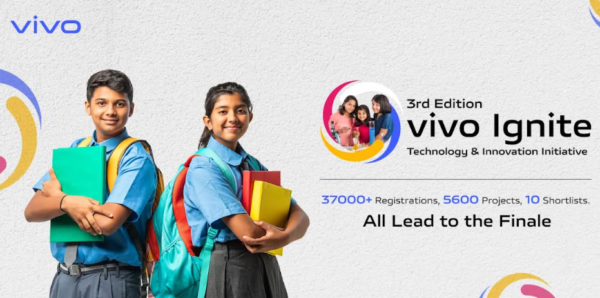19 Young Indians Named Finalists in 3rd Edition of vivo Ignite Tech Innovation Contest
3rd Edition of vivo Ignite : Technology and Innovation Finalists Announced – 19 Young Indian Students Champion Societal Change Through Tech Innovation

New Delhi, 10 June 2025: As the third edition of vivo Ignite reaches its culmination, young Indian students from Grades 8 to 12 are demonstrating extraordinary vision to address societal challenges through innovation.
vivo India, a trusted smartphone brand, has announced the top 10 Ideas, represented by 19 young finalists of its nationwide flagship program – vivo Ignite Technology and Innovation. These outstanding project ideas were selected from over 5,600 submissions, representing a rich diversity of thought, creativity and purpose.
Developed by 19 exceptional young minds, the winning ideas exemplify a unique blend of technology, creativity and intent, offering practical solutions to some of the most pressing societal challenges. The vivo Ignite initiative is designed to nurture problem-solving and analytical thinking among India’s youth and provides students with access to mentorship, resources, and a structured platform to turn their ideas into impactful, tech-driven solutions.
With participation from more than 9,000 schools across 660+ districts, this year’s final has witnessed remarkable diversity. Finalists hailed from diverse regions including Haryana, Gujarat, Karnataka, Maharashtra, Pondicherry, Odisha and West Bengal.
Out of nearly 200 shortlisted ideas, 10 transformative innovations stood out — developed by a balanced cohort of 9 boys and 10 girls. The regional distribution of finalists underscored the truly national character of the program: North and South India each contributed two finalist ideas each from the region, while East and West India were represented by three finalists each. Students from Grade 9 formed the largest group, with 13 out of the 19 finalists part of the top 10 ideas, followed by students from Grades 11 (3 students), 8 (2 students), and 10 (1 student)—a testament to the early spark of innovation among young minds.
The Top 10 projects selected this year exemplify how young innovators are applying technology to address real-world challenges—from climate action to inclusive healthcare and rural access. Each idea reflects a deep understanding of community needs and highlights the growing strategic relevance of youth-led innovation in India’s development journey.
- AI-Guru Box: Offline AI Voice System to Assist Rural Communities by Binayak Sengupta: An AI powered rural information hub that bridges the knowledge divide by delivering real time access to healthcare, legal rights, and government schemes, fostering inclusive and sustainable community development.
- Electro-Hub (Community Scale Electricity Producer) by Ritika Jumle and Falguni Kishor Chaudhari: Algae-Biofueler BioNova system that is focused on sustainable biofuel production by a farming technique innovation called, “Pranahakosh” along with a community-based machinery that aims on producing electricity and purifying air too. The first conceptual biofuel engine of India that is very budget-friendly, environment-friendly and recycles CO2 rather than emitting it.
- Arduino Based LPG Gas: Arduino Based LPG Gas Leakage Detection and Prevention System by Kushaal Abhay, Vamshikha K S, & Dhriti Kannan: An automated safety mechanism that enables quick response to accidental LPG leaks, prioritizing prevention and disaster control. An easy-to-install system offering enhanced protection for nearby individuals by significantly reducing leak risks, despite challenges like cost, and network coverage in some areas.
- Nanocomposite Sealants Restoration: Upcycling Waste into Nanocomposite Sealants for Concrete Crack Restoration by Supriya S & Saruhasini V: A system that utilizes waste-derived nanocomposite sealants for concrete crack repair, offering enhanced durability, crack and water resistance. It presents a sustainable, cost-effective alternative to conventional methods, though further optimization is needed for large-scale infrastructure application.
- Smart Navigation Cane: Smart Navigation Cane for the Visually Impaired by Nilesh Kumar: A smart cane designed to enhance mobility and independence for visually impaired individuals. Reduces pedestrian accidents with real time obstacle alerts. Provides emergency SOS response with Live GPS tracking, Traffic light detection and weather alerts to improve outdoor planning and safety.
- Fab-Brick by Shreeja Mahadik & Harshita Taral: A superglue made from acetone and thermocol that can effectively bind fabric waste to form bricks suitable for non-load-bearing construction. This method highlights a practical approach towards recycling textile waste into usable building materials.
- ArmX – Smart Rehabilitation System for One-Hand Paralyzed Individuals by Devarsh Patel, Veer Manvar, & Kavan Patel: A smart rehabilitation system for individuals with one-hand paralysis, utilizing a sensor-equipped glove to capture hand movements and relay them to a robotic arm that replicates the motion on the affected hand. This non-invasive, interactive setup facilitates movement therapy, gradually improving mobility, strength, and neuroplasticity, thereby fostering greater independence and quality of life.
- Green Run for Green Souls (From Wind to Wheels) by Safin Mallick, Sirsa Naskar, & Agamani Pandey: This project is commercially viable by leveraging renewable wind energy for EV charging stations, reducing dependence on traditional power sources. With India’s vast highway network and growing EV market, scalability is achievable by installing more VAWT towers along highways. The project offers cost savings on infrastructure, aligns with sustainable goals, and promotes green energy.
- Trevive: A Device to Monitor Real-Time Health of Trees by Abeer Gosain: Trevive is a scalable, low-cost solution adaptable for urban and rural landscapes. It’s simple yet effective technology that makes it viable for municipalities, schools, and conservation programs. The mobile app ensures accessibility and provides valuable insights for large-scale tree health assessment. With further automation, Trevive can become a commercialized tool for global tree conservation efforts.
- AI Powered Criminal Activity Detection: Al Powered Criminal Activity Detection Through Sensor Less Sensing by Prateek Sethi: A cost-effective, large-scale crime detection system using Wi-Fi sensing technology. It offers non-intrusive surveillance capable of distinguishing between normal and suspicious human activities, making it suitable for enhancing security across public spaces, homes, and organizations.
The competition is close to its culmination with Grand Finale scheduled for June 15, 2025, in New Delhi. As part of the recognition and encouragement for outstanding performance, scholarships will be awarded to both individual and group winners. Individual participants securing the top five ranks will receive scholarships of INR 4 lakhs, INR 3 lakhs, INR 2 lakhs, INR 1.5 lakhs, and INR 0.75 lakh respectively. Whereas in the group category, scholarship amounts range from INR 9 lakhs for winner, INR 6 lakhs for 2nd positions, INR 4.5 lakhs for 3rd position, INR 3 lakhs for 4th position, and INR 1.5 lakhs will be awarded to the 5th rank holding teams respectively.
As the nation awaits the finale, the vivo Ignite platform continues to inspire a new generation of changemakers driven by science, technology, and purpose. vivo Ignite has established itself as a powerful platform for discovering promising young innovators and equipping them with the resources, mentorship, and recognition needed to transform their ideas into real-world impact.


